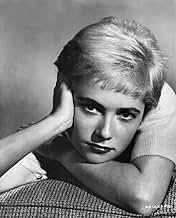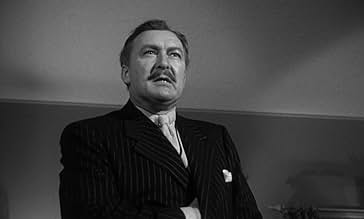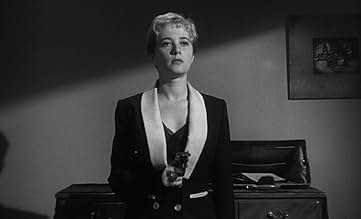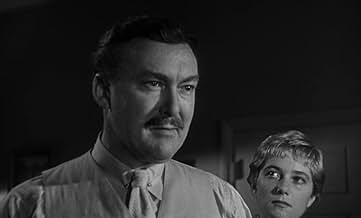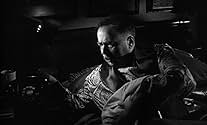NOTE IMDb
7,5/10
23 k
MA NOTE
La mort d'une autostoppeuse entraîne Mike Hammer dans un tourbillon mortel d'intrigues, tournant autour d'un mystérieux « formidable cékoi ».La mort d'une autostoppeuse entraîne Mike Hammer dans un tourbillon mortel d'intrigues, tournant autour d'un mystérieux « formidable cékoi ».La mort d'une autostoppeuse entraîne Mike Hammer dans un tourbillon mortel d'intrigues, tournant autour d'un mystérieux « formidable cékoi ».
- Réalisation
- Scénario
- Casting principal
- Récompenses
- 1 victoire et 1 nomination au total
Marian Carr
- Friday
- (as Marion Carr)
Mady Comfort
- Nightclub Singer
- (as Madi Comfort)
Avis à la une
Movies like "Kiss Me Deadly" are reassuring that there's more to each genre than meets the eye. "Kiss Me Deadly" is part hard-boiled detective story & part apocalyptic sci-fi horror film. The movie suspects its own plots and its conventions are ludicrous. The result is a highly inventive film with a ridiculous but highly enjoyable storyline and comically fascinating characters.
The basic plot, loosely adapted from Mickey Spillane's bestselling novel,is: after private-eye Mike Hammer picks up a hitchhiker who is later murdered, he becomes determined to learn the truth about her death. Although the plot becomes more and more insane, it's highly interesting. There are no empty twists, as each one leads to something larger and more confounding.
I've never had more fun with a film noir character than the aptly named character of Mike Hammer. He isn't intimidated by any man and denies the world's hottest women. If he holds the upper hand in a situation, he seems virtually impenetrable. This characteristic leads to the ever-prevalent theme in film noirs of men vs. women and their places in relationships and society.
The film is a masterpiece of cinematography, exhibited in the disorienting camera angles and unique and unconventional compositions of Ernest Laszlo. In fact, Ernesto Laszlo's cinematography is so apt with the film's randomness that it made me giddy.
One of the most distinctive aspects of Kiss Me Deadly is the outrageousness of its final few seconds: the movie doesn't conclude, it detonates. In the hands of the director Robert Aldrich, the film becomes a starting point for a delirious expression of 1950s anxiety and paranoia, starting with opening credits that run backwards and ending with an atomic explosion.
The basic plot, loosely adapted from Mickey Spillane's bestselling novel,is: after private-eye Mike Hammer picks up a hitchhiker who is later murdered, he becomes determined to learn the truth about her death. Although the plot becomes more and more insane, it's highly interesting. There are no empty twists, as each one leads to something larger and more confounding.
I've never had more fun with a film noir character than the aptly named character of Mike Hammer. He isn't intimidated by any man and denies the world's hottest women. If he holds the upper hand in a situation, he seems virtually impenetrable. This characteristic leads to the ever-prevalent theme in film noirs of men vs. women and their places in relationships and society.
The film is a masterpiece of cinematography, exhibited in the disorienting camera angles and unique and unconventional compositions of Ernest Laszlo. In fact, Ernesto Laszlo's cinematography is so apt with the film's randomness that it made me giddy.
One of the most distinctive aspects of Kiss Me Deadly is the outrageousness of its final few seconds: the movie doesn't conclude, it detonates. In the hands of the director Robert Aldrich, the film becomes a starting point for a delirious expression of 1950s anxiety and paranoia, starting with opening credits that run backwards and ending with an atomic explosion.
So the big what'sit is what it's all about and this big what'sit is without a doubt, flat out phenomenal. Ralph Meeker snarls and sneers his way thru a bevy of sadism and selfishness in this superb, unflinching look at amorality beneath happy go lucky 50's sensibilities. Biting and wicked and never dull, and filled with more amazing characters than one movie deserves, this is a knock out classic that you will enjoy wallowing in repeatedly.
This late entry into the film noir genre has some harsh and memorable scenes and an ending unlike any other film noir. Of course, most of those weren't made during the A-Bomb scares of the mid 1950s, as this was.
The movie features a tough, no-nonsense Mike Hammer-like private eye, played well by Ralph Meeker, whose tough-guy dialog is a little dated but still fun to hear. This is one of those noirs in which everyone is a tough-talking, tough-acting mug and one never knows who to trust. Except for Cloris Leachman, who is only in the first quick (but haunting) opening scene, the females in here are unfamiliar actresses but people with interesting faces and personalities.
That opening with Leachman is a real attention-grabber and is one of the best starts I've ever seen in a crime movie. It's very creepy, as is the unique ending. I also appreciated the cinematography in here a lot more once the DVD was issued.
The movie features a tough, no-nonsense Mike Hammer-like private eye, played well by Ralph Meeker, whose tough-guy dialog is a little dated but still fun to hear. This is one of those noirs in which everyone is a tough-talking, tough-acting mug and one never knows who to trust. Except for Cloris Leachman, who is only in the first quick (but haunting) opening scene, the females in here are unfamiliar actresses but people with interesting faces and personalities.
That opening with Leachman is a real attention-grabber and is one of the best starts I've ever seen in a crime movie. It's very creepy, as is the unique ending. I also appreciated the cinematography in here a lot more once the DVD was issued.
Robert Aldrich was a no-nonsense film director. When he undertook the direction of this film, little did he know it was going to become the extraordinary movie it turned out to be. The fame seems to have come by its discovery in France, as it usually is the case. Based on Mickey Spillane's novel and adapted by Al Bezzerides, the movie has an unique style and it's recommended viewing for fans of the film noir genre.
Right from the start, the film gets our imagination as we watch a young woman running along a California highway. That sequence proved Mr. Aldrich's ability to convey the idea of a disturbed young woman that seems to have escaped from a mental institution. The plot complicates itself as Hammer learns that Christine, the young woman, has died. He decides to investigate, which is what he does best.
Some excellent comments have been submitted to this forum, so we will not even try to expand in the action but will only emphasize in the tremendous visual style Mr. Aldrich added to the film, which seems to be its main attraction. For a fifty year old film, it still has a crisp look to it thanks to the impressive black and white cinematography of Ernest Lazlo, who had a keen eye to show us Hammer's world as he makes it come alive. The great musical score by Frank DeVol fits perfectly with the atmosphere of the L.A. of the fifties.
Ralph Meeker made an excellent contribution as Mike Hammer. He dominates the film with his presence. Albert Decker, Paul Stewart, Miriam Carr, Maxine Cooper, Fortuno Bonanova, and especially Cloris Leachman, in her screen debut, make this film the favorite it has become.
Fans of the genre can thank Mr. Aldrich for making a film that didn't pretend to be anything, yet has stayed as a favorite all these years.
Right from the start, the film gets our imagination as we watch a young woman running along a California highway. That sequence proved Mr. Aldrich's ability to convey the idea of a disturbed young woman that seems to have escaped from a mental institution. The plot complicates itself as Hammer learns that Christine, the young woman, has died. He decides to investigate, which is what he does best.
Some excellent comments have been submitted to this forum, so we will not even try to expand in the action but will only emphasize in the tremendous visual style Mr. Aldrich added to the film, which seems to be its main attraction. For a fifty year old film, it still has a crisp look to it thanks to the impressive black and white cinematography of Ernest Lazlo, who had a keen eye to show us Hammer's world as he makes it come alive. The great musical score by Frank DeVol fits perfectly with the atmosphere of the L.A. of the fifties.
Ralph Meeker made an excellent contribution as Mike Hammer. He dominates the film with his presence. Albert Decker, Paul Stewart, Miriam Carr, Maxine Cooper, Fortuno Bonanova, and especially Cloris Leachman, in her screen debut, make this film the favorite it has become.
Fans of the genre can thank Mr. Aldrich for making a film that didn't pretend to be anything, yet has stayed as a favorite all these years.
Man, I saw this movie for the first time a few years ago and I still don't know what to think about it. Ralph Meeker as a fascistic Mike Hammer, a crazy hitch-hiker, an opera fan and a box that can destroy the world. I dunno.
From what I understand Alderitch (the director) hated Mikey Spillane's story (which was about a briefcase full of drugs or money or something else), thought Mike Hammer was an image of brutality and fascism and made a film that reflected it. He makes Hammer out to be some kind of sadist and makes the suitcase out be some kind of nuclear device. The movie turns from a simple detective story to some wierd-ass, sci-fi cold war parable.
It's sort of like the X-Files meets film-noir PI, or something to that effect.
All that being said, this is a GREAT film and is well worth watching by anyone who like apocalyptic film-noir (in fact, this may be the only film in that sub-genre). Anyone who is a fan of bizarre camera work, weird symbolism and a stranger storyline, should really check this out.
Observe the many bizarre inconsistencies (clocks that jump ahead and back, screams that don't jibe right with the soundtrack, camera angles that jump mysteriously) and keep in mind that these were INTENDED! When you get a feel for this film and start noticing what the director was attempting to do with this bizarre film I think that you will enjoy it even more. Truly a unique piece of film making.
From what I understand Alderitch (the director) hated Mikey Spillane's story (which was about a briefcase full of drugs or money or something else), thought Mike Hammer was an image of brutality and fascism and made a film that reflected it. He makes Hammer out to be some kind of sadist and makes the suitcase out be some kind of nuclear device. The movie turns from a simple detective story to some wierd-ass, sci-fi cold war parable.
It's sort of like the X-Files meets film-noir PI, or something to that effect.
All that being said, this is a GREAT film and is well worth watching by anyone who like apocalyptic film-noir (in fact, this may be the only film in that sub-genre). Anyone who is a fan of bizarre camera work, weird symbolism and a stranger storyline, should really check this out.
Observe the many bizarre inconsistencies (clocks that jump ahead and back, screams that don't jibe right with the soundtrack, camera angles that jump mysteriously) and keep in mind that these were INTENDED! When you get a feel for this film and start noticing what the director was attempting to do with this bizarre film I think that you will enjoy it even more. Truly a unique piece of film making.
Le saviez-vous
- AnecdotesThe Kefauver Commission, a federal unit dedicated to investigating corrupting influences in the 1950s, singled this out as 1955's number one menace to American youth. Because of this, Robert Aldrich felt compelled to conduct a writing campaign for the free speech rights of independent filmmakers.
- GaffesAt the beginning, Christina (Cloris Leachman) is shown running at the side of the highway, but the shots of only her feet show her running along the painted center line of the highway.
- Citations
Mike Hammer: You're never around when I need you.
Velda: You never need me when I'm around.
- Crédits fousThe opening credits scroll down instead of the usual up, resulting in needing to read them bottom to top.
- Versions alternativesUntil 1997, all known copies in circulation of "Kiss Me Deadly" ended rather abruptly: the wounded Mike Hammer stumbling through the beach house looking for his partner Velda, and then there's a couple of brief shots of the house exploding and burning, with "The End" superimposed on the final shot. The music is cut off instead of fading out, and the screen turns black; it looks like Mike and Velda died in the blaze.
- ConnexionsEdited into American Cinema: Film Noir (1995)
- Bandes originalesRather Have the Blues
Sung by Nat 'King' Cole
Written by Frank De Vol (uncredited)
[Played on the car radio during the opening title card and credits]
Meilleurs choix
Connectez-vous pour évaluer et suivre la liste de favoris afin de recevoir des recommandations personnalisées
Détails
- Date de sortie
- Pays d’origine
- Langues
- Aussi connu sous le nom de
- El beso mortal
- Lieux de tournage
- Clay Street, Bunker Hill, Downtown, Los Angeles, Californie, États-Unis(Mike parks his Corvette and takes the back steps up to the Hillcrest Hotel)
- Société de production
- Voir plus de crédits d'entreprise sur IMDbPro
Box-office
- Budget
- 410 000 $US (estimé)
- Montant brut aux États-Unis et au Canada
- 726 000 $US
- Montant brut mondial
- 952 000 $US
- Durée
- 1h 46min(106 min)
- Couleur
- Rapport de forme
- 1.85 : 1
Contribuer à cette page
Suggérer une modification ou ajouter du contenu manquant




